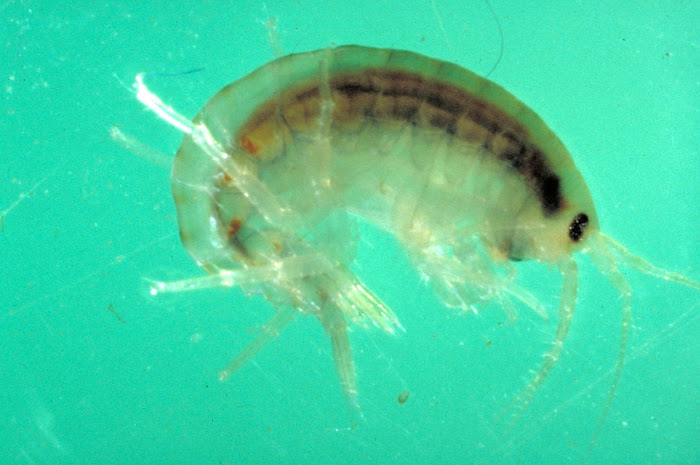
SCUDS - The common North American name for amphipods in the family Gammaridae.
Scientific Classification:
Phylum - Arthropoda
Subphylum - Crustacea
Class - Malacostraca
Order - Amphipoda
Suborder - Gammaridea
Family - Gammaridae
Genus - Gammarus
At the poster end, gammarideans have three pairs of uropods, which are tail limbs. Most appendages found on organisms with this family are paired. Scuds contain seven pairs of walking legs and two pairs of antennae. Generally, the body is flattened from side to side.
There are various species of Gammarus but all exhibit this same basic body form.
Scuds range from translucent to light brown or gray in colour and from five to twenty millimeters in length.
Gammarus sp. are omnivores and detritivores. They feed on live plant and animal material such as fungus, bacteria and algae. They also feed on decaying matter, or detritus!
Ecologically, they play an important role as detritivores because they recycle dead matter back into the environment. They are also a prey source for many fish and larger invertebrates. Gammarus species are nocturnal organisms that typically feed at night.
Amphipods are the most abundant order within the Crustacea. They inhabit a wide range of ecological niches and habitats ranging from rocky intertidal zones to lakes, ponds and streams in mainly mid-latitudes around the globe. They prefer shallow water habitats that are no more than approximately one meter in depth. There are a few species of Gammarus that exploit terrestrial habitats.
In isolated environments with little to no predation, Gammarus populations can reach up to 10,000 organisms per square meter!
During mating, Gammarus exhibit behaviour that is referred to as amplexus. The male will grasp the female between it's legs and carrier her during reproduction.
Sperm are transferred from the male into the female genital duct. The female releases the eggs into a brood pouch and are incubated during development.
•
•

No comments:
Post a Comment